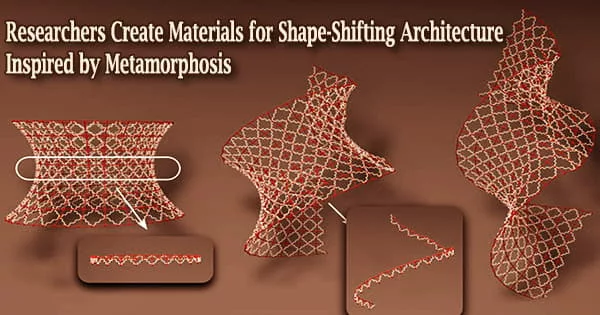North Carolina State University researchers have found materials that can be used to make structures that can transform into a variety of topologies. The researchers envisage a variety of uses, including building and robotics.
“The system we’ve developed was inspired by metamorphosis,” says Jie Yin, corresponding author of a paper on the work and an associate professor of mechanical and aerospace engineering at NC State. “With metamorphosis in nature, animals change their fundamental shape. We’ve created a class of materials that can be used to create structures that change their fundamental architecture.”
Kirigami is a key theme in Yin’s work. Kirigami is a type of origami in which the paper is cut and folded. While kirigami generally uses two-dimensional materials, Yin uses three-dimensional materials to apply the same ideas.
A single 3D kirigami unit serves as the foundation for the metamorphosis system. Each unit is capable of forming a variety of shapes on its own. However, because these elements are modular, they can be linked together to create increasingly complicated structures.
Because the individual units can take on a number of shapes and connect to other units in a variety of ways, the total system can create a vast range of structures.
“Think of what you can build with conventional materials,” Yin says. “Now imagine what you can build when each basic building block is capable of transforming in multiple ways.”
The metamorphosis kirigami system does not allow you to disassemble a structure. And because the sides of each cubic unit are rigid and fixed at 90-degree angles, the assembled structure does not bend or flex very much. However, the finished structure is capable of transforming into different architectures.
Jie Yin
A similar concept was previously presented by Yin’s lab, in which 3D kirigami units were piled on top of each other. The units may be used to assemble a structure in that system, but the structure could also be disassembled.
The metamorphosis system entails joining the kirigami pieces together. To put it another way, once the units are connected, they cannot be separated. The larger structures they build, on the other hand, can be transformed into a variety of distinct architectures. Video of the metamorphosis system can be seen at https://www.youtube.com/watch?v=hOplS5J_wHI.
“There are two big differences between our first kirigami system and the metamorphosis system,” Yin explains.
The initial kirigami system used units that could be put together into architectures and then dismantled, which was a benefit. The architecture, however, would not be able to transform after the parts were assembled.
The constructed structure could bend and move but not fundamentally change its geometry because the sides of the unit were not rigid and locked at 90-degree angles.
“The metamorphosis kirigami system does not allow you to disassemble a structure,” Yin says. “And because the sides of each cubic unit are rigid and fixed at 90-degree angles, the assembled structure does not bend or flex very much. However, the finished structure is capable of transforming into different architectures.”
The metamorphosis system was proved in proof-of-concept testing to be capable of constructing a variety of structures capable of carrying large weight while retaining structural integrity.
Because Yin believes construction is one potential use for the metamorphosis system, structural soundness is critical.
“If you scale this approach up, it could be the basis for a new generation of construction materials that can be used to create rapidly deployable structures,” Yin says. “Think of the medical units that have had to be expanded on short notice during the pandemic, or the need for emergency housing shelters in the wake of a disaster.”
The metamorphosis system might also be utilized to develop a range of robotic devices that can transform in response to external stimuli or perform different functions, according to the researchers.
“We also think this system could be used to create a new line of toys particularly toys that can help people explore some fundamental STEM concepts related to physics and engineering,” Yin says. “We’re open to working with industry collaborators to pursue these and other potential applications for the system.”
The paper, “Metamorphosis of three-dimensional kirigami-inspired reconfigurable and reprogrammable architected matter,” is published in the journal Materials Today Physics. First author of the paper is Yanbin Li, a Ph.D. student at NC State. The work was done with support from the National Science Foundation, under grant 2005374.
















